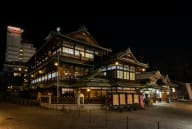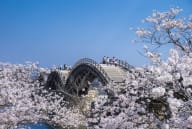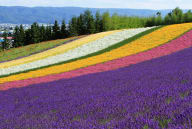Tout ce que vous devez savoir sur le sentier Subashiri avant de partir escalader le mont Fuji
Une diversité de terrains, moins de randonneurs, ainsi qu'une descente amusante en font un itinéraire idéal pour attaquer le mont Fuji . Débutant à environ 2000 mètres au-dessus du niveau de la mer, le sentier Subashiri comporte des tronçons couverts d'arbres et un superbe panorama. Il existe de nombreuses installations sur cet itinéraire et tout le chemin est orienté vers l'est, ce qui en fait un excellent choix pour contempler le lever de soleil.
Coup d'œil sur le sentier Subashiri
Commencez à la 5e station Subashiri, à 1970 mètres au-dessus du niveau de la mer
Ascension : environ 5 à 7 h, à l'ombre des arbres pendant la première moitié
Descente : de 2 h 30 à 4 h environ, incluant un tronçon agréable que vous pouvez descendre en courant à partir de la 7e station
L'ascension et la descente suivent des chemins différents
Aperçu de l'itinéraire
Le Subashiri est l'itinéraire le moins emprunté, mais cela ne signifie pas qu'il n'en vaut pas la peine. La première moitié de l'escalade (jusqu'à environ la 7e station) vous entraîne à travers une zone forestière pleine d'ombre pour échapper au soleil. Cet itinéraire est connu pour ses longs tronçons de sable et de gravier volcaniques en descente, qui peuvent être parcourus rapidement. Sachez que ce sentier fusionne avec le sentier Yoshida le plus populaire après la 8e station, pouvant entraîner un ralentissement de votre rythme et un certain encombrement au sommet à l'approche du lever de soleil. Par chance, vous pouvez observer le lever de soleil où que vous le souhaitiez le long du sentier Subashiri dès lors que vous êtes au-dessus de la limite des arbres.

Installations
Le sentier Subashiri dispose d'un bon nombre de refuges au fur et à mesure de votre progression. La plupart des stations disposent de refuges de montagne avec des toilettes (200 à 300 yens), de la nourriture et des boissons. Vous pouvez acheter un bâton de marche en chemin et le faire tamponner à chaque refuge de montagne. Le trek à partir de la 8e station jusqu'au sommet est la section de randonnée la plus longue, durant environ 1 h 40 sans aucun répit. Assurez-vous donc de faire une halte au refuge Guraikokan, car c'est le dernier refuge avant d'atteindre le sommet.
Début de votre trek
Rendez-vous en bus à la 5e station Subashiri sur le flanc oriental de la montagne. Des bus partent de la gare de Gotemba de 7 h 35 à 17 h 35 (un bus presque chaque heure). Un billet aller-retour coûte 2100 yens. À la 5e station se trouvent deux boutiques, un centre d'information touristique et des toilettes. Sachez qu'il n'y a pas de vestiaires disponibles, veuillez donc n'apporter que ce dont vous avez besoin pour la randonnée.



Accès au point de départ du sentier de randonnée
Pendant la saison d'escalade, le moyen le plus facile d'y accéder est de prendre un bus à la gare de Gotemba. Sinon, rejoignez en voiture le parking de Subashiri et prenez la navette jusqu'au point de départ de la 5e station.
L'ascension
De la 5e station jusqu'au sommet, veuillez prévoir au moins 5 h 30 d'effort. La moitié inférieure de l'ascension est une randonnée agréable à travers des zones forestières. Le plus long tronçon se trouve entre la 8e station et le sommet, il dure environ 1 h 40. C'est aussi l'endroit où le sentier fusionne avec le sentier Yoshida , devenant ainsi plus encombré. Veuillez faire attention, surtout les week-ends et les jours fériés, car cette dernière portion peut prendre beaucoup plus de temps en raison de la grande quantité de randonneurs avançant sur des tronçons étroits.
Lors de la descente, faites très attention lorsque vous approchez de la 8e station. Le chemin se divise et il est facile d'emprunter la mauvaise direction sur le sentier Yoshida , pouvant vous mener à une 5e station différente de celle d'où vous êtes parti.e. À la 7e station se trouve la section osunabashiri (course sur le sable) du sentier. Assurez-vous d'avoir mis vos guêtres et amusez-vous à descendre le sédiment volcanique à grandes enjambées.


Où séjourner
Pour ceux qui désirent séjourner dans un refuge de montagne avant d'effectuer une ascension au lever du soleil, il est fortement recommandé de réserver avant d'escalader la montagne.
Goraikokan se situe à la station de mi-parcours, entre la 8e et la 9e station, à environ 3450 mètres au-dessus du niveau de la mer. Le dortoir est rudimentaire : on vous fournit une couverture et un oreiller, et vous dormez au côté des autres hôtes dans une salle commune. Comptez 11 000 yens minimum la nuit.
Pour plus de renseignements et pour en savoir plus sur les autres hébergements disponibles, consultez la liste complète des refuges du mont Fuji .













































